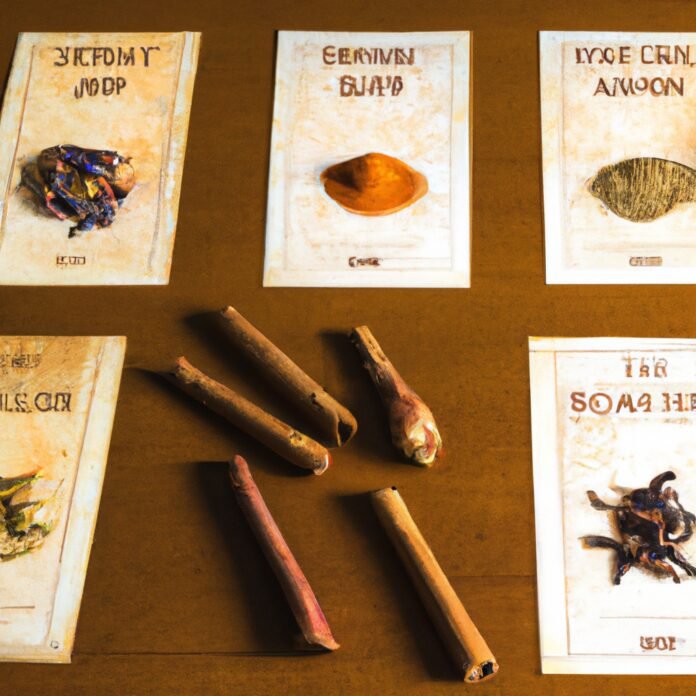From the captivating aromas arising from the streets of India, to the spicy-savory flavours of the Far East– the scent of exotic spices has enchanted travelers for centuries across the globe. Join us on a cultural and culinary journey, as we explore the mysterious and mesmerizing spices from different parts of the world. Step into the adventurous and unknown world of “Spice Trails” and discover a new way of navigating exotic flavors and aromas!
1) Exploring the World of Global Cuisine: Spice Trails
Do you miss the taste of authentic Mexican tacos or the smoky aroma of Malaysian laksa that you discovered on your travels? Are you a lover of Indian curries and Vietnamese spring rolls? Fortunately, you no longer need to hop on a plane to try a new cuisine – the Spice Trails of Global Cuisine can bring the flavors of foreign lands right to your own kitchen!
If you have an adventurous taste and an appetite for exploring, a world of flavour awaits you. Whether you are a novice or experienced cook, following a recipe or experimenting with tastes, embarking upon the Spice Trails will open your senses to a multitude of delightful, exotic and delectable dishes.
Here are a few tips to get you started:
- Great recipes don’t have to be complicated. Start with simple dishes with limited ingredients and work your way up.
- Add a few ingredients at a time and adjust the flavors to suit your palate.
- Use fresh ingredients wherever possible to maintain the authentic taste of the dish.
- Be organized when selecting your spices and sauces. Stock up on a few basics such as garlic, ginger, coriander, cumin and turmeric, and try different combinations.
- Be adventurous and try something new – the possibilities are endless!
For a truly unique experience, don’t be afraid to explore cuisines and ingredients outside your comfort zone! Your taste buds will thank you for it.
2) The Journey of Flavors: Aromatic Pleasures of Different Cultures
Traveling is one of the best ways to experience the flavors of different cultures. From the silky-smooth richness of teriyaki in Japan, to the warm, earthy spices of regional Indian dishes, there’s something for everyone. Each culture has its own unique flavors that make it stand out from the rest, and experiencing them firsthand is the best way to appreciate all that a culture has to offer.
- Silky-smooth teriyaki from Japan
- Fiery sunchokes from Peru
- Classic tangy kimchi from Korea
- Velvety Indonesian Gado Gado
- Pleasantly sweet lychee from India
- Tart blood orange from Italy
- Smoky ananás chili from South America
- Spicy Thai curries
- Exotic smoky berbere from Ethiopia
- Zesty coriander from India
Experience these flavors and aromas yourself, and you will unlock a whole new world of cultural tastes. From sweet and savory, to tart and spicy — Every culture has something to offer when it comes to aromatic flavors.
3) Discovering the Exciting Tastes of Unknown Worlds
What’s better than exploring and discovering new and unknown lands? Exploring and discovering new and exciting foods and tastes. It’s easy to get bored with the familiar tastes of everyday life, but seeking out new and unknown flavors is an exciting adventure.
From savory snacks to exotic dishes, you’ll find a variety of options out there. Here are a few ideas to get you started:
- The Local Cuisine: Every region in the world has a unique set of flavors. From familiar Italian and Mexican cuisine to the exotic flavors of Africa or India, there’s something to try wherever you are!
- Ethnic Groceries: Ethnic grocery stores are a great way to find interesting and unusual ingredients. Why not try cooking up a dish with ingredients from a new culture? Who knows, you might discover a new favorite flavor.
- Food Festivals: Food festivals provide a great opportunity to sample a variety of locally-produced foods and flavors. Make sure to try some of the regional specialties!
Adventuring into new and unknown food worlds is a great way to expand your culinary horizons. You never know what amazing tastes await.
4) Balancing Traditional with the Avant-garde: Navigating Exotic Cuisines
The concept of exotic cuisine is nearly undefined and open to interpretation. What may be considered exotic to a certain person can be comfort food to another; therefore it has become increasingly important to balance traditional and the avant-garde when it comes to exploring these types of meals. Here are 4 ways to help you do just that:
- Research: Before trying a new cuisine, dedicate some time to research. Research the cuisine’s specific ingredients, any cultural norms that are associated with it, unique flavours, and techniques to master.
- Simplify: Not all exotic cuisine dishes have to be elaborate. Certain dishes, especially those from the Far East, will take extremely long time to prepare. Shorten the preparation time by simplifying ingredients and opting for pre-made sauces.
- Experiment: To fully understand a cuisine’s flavour palette, do not be afraid to experiment. Use different combinations of flavours and spices to create something unique and savoury.
- Pairings: Finally, learn how to pair traditional dishes with ones that are inspired by the avant-garde. For instance, Middle Eastern dishes are often paired with a traditional salad or soup. Integrating the two seamlessly can be very rewarding and provide a more complete experience.
Through collaborating research and experimenting with different flavours, it is possible to navigate the ever-evolving world of exotic cuisine. Find what works best for you and strive to create a dynamic balance of both traditional and avant-garde dishes.
5) Exploring Tradition with a Modern Twist: Spice Trails and Beyond
The world of cookery has seen its fair share of evolution through the centuries, with new ingredients, dishes and flavours making their way onto our plates. With so many cultures, traditions and techniques, to explore, the culinary landscape is always ripe with discovery. In this section, we take a closer look at spices, and investigate how they can be used to add a modern twist to classic dishes.
- Spice trails: The familiar sting of anise, the peppery heat of chilli, the sweet pungency of cinnamon; spices have been used by cooks for centuries to provide variations in flavour and texture. Taking a tour of the world’s spice trails is as much a culinary adventure as it is a journey through history.
- Fusion flavours: Combining spices with modern ingredients to create dishes beyond the classic recipes can be an innovative experience. Seek out a dish which uses traditional and homegrown herbs alongside foreign spices, and explore the possibilities of fusion cooking.
- Cross-cultural twists: From Moroccan tagines to Indian curries, many recipes have become iconic of their countries of origin. Why not recreate some of these classic dishes, replacing the spices with a modern twist? Experimenting with other ingredients, like an unusual oil or more ingredients, can provide a contrast with the standard recipe.
Whether one chooses to follow the classic routes or explore innovative blends, there’s no limit to the kind of dishes that can be created with spices. Explore the culinary heritage of different cultures, stay true to classic recipes or play around with fusion flavours; the possibilities are endless, with spice trails and beyond.
From the ancient Silk Road to the crowded marketplaces of India, the Spice Trail is an essential part of our cultural landscape. Whether it’s for your pantry or your palette, take some time this week to explore the different flavors and aromas that come from around the world. Follow the Spice Trail, and see where it takes you!

